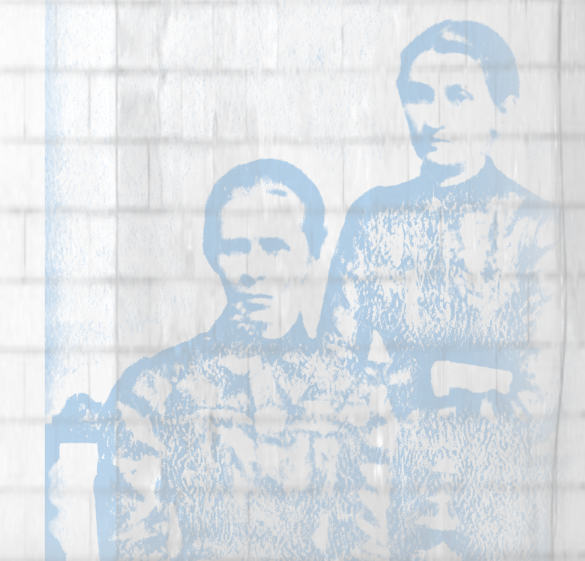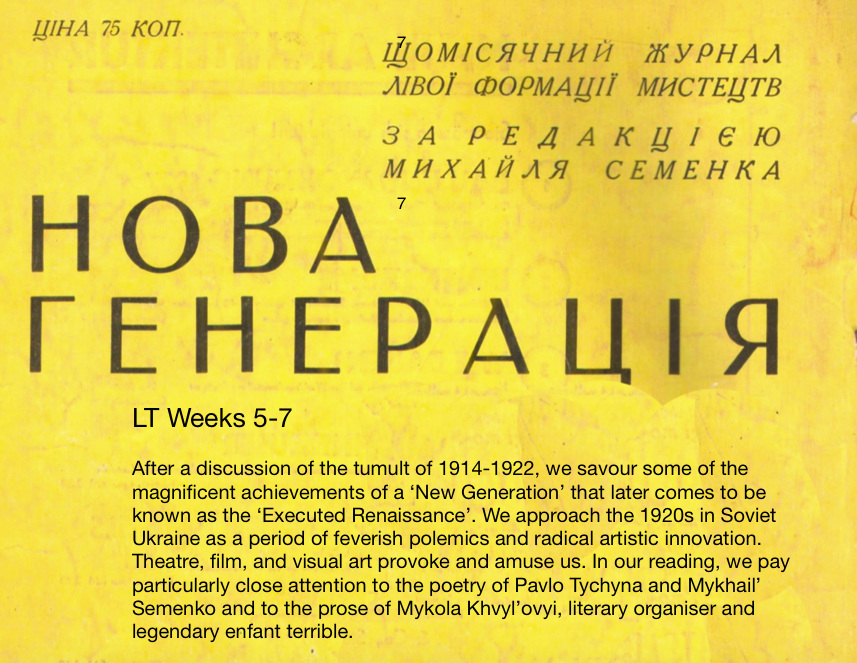Ukraine is a dynamic��country that is '“in between” in all possible ways', in the words of the Ukrainian intellectual Mykola Riabchuk. This paper introduces you to the rich language, literature, and culture of the largest country within the European continent, which is the site of a 'frozen conflict' in Crimea and an ongoing international armed conflict in Donbas.��It seizes upon Ukraine's 'in-betweenness' - the historical permeability of its territorial, linguistic, and ethnic borders - as an opportunity to explore the interdependency of the cultures of Eastern Europe and the Black Sea region.
Ukraine owes its very existence to works of culture. Particularly in the early- and mid- nineteenth century, these humorous, tortured, satirical, sublime texts cultivated the idea of freedom at odds with aristocracy to the west and autocracy to the east. In this paper, you will explore these works while grappling with an extraordinary history that saw a modern nation defy sociopolitical gravity and evolve out of the periphery of three empires to establish a sovereign, independent state. You will trace the development of today's Ukraine from the burlesque travesty of Kotliarevs'kyi to the passionate Romanticism of Shevchenko, from the feminist stories of Kobylians'ka to the postcolonial novels of Kurkov. You will recite poetry, debate novels, unroll canvasses, reinterpret folksongs, rekindle debates among the avant garde -- all the while acquiring a command of the fundamentals of the Ukrainian language.
the paper prospectus��here or browse below.
Who can take paper SL9?
This paper is open to all MMLL and HML students and available in both Part IB and Part II.��No previous knowledge of Ukrainian is expected or required.��
��
TOPICS

Black Swan: Modern Ukrainian Culture and Its Muses MT Weeks 1-3
In this first section, guided by the figure of the mysterious Kozak Mamai, we rush headlong into the complex and contested history of the territory now known as Ukraine. We explore the legacies of the era of (Kyivan) Rus’; tour the Cossack Baroque; witness the loss of 17th-/18th- century Ukrainian political autonomy; and then relish the first work of modern Ukrainian literature: Ivan Kotliarevs'kyi's erudite, manic, and ribald travesty (mock epic) Eneida of 1798.
Dedicated Followers of Fashion: Kotliarevshchyna, Gogol’, and the Performance of Ukrainian Culture MT Weeks 4-5
Here we take stock of the lasting influence of Ivan Kotliarevs’kyi’s portrayal of modern Ukrainian culture in the works of his epigones (‘poor’ imitators), the so-called kotliarevshchyna. These writers set the stage for the arrival of another innovative young writer from the Poltava region: Nikolai Gogol’. In reading selected works by Petro Hulak-Artemovs’kyi and Gogol’, we seek to understand the interest of the imperial centre in the culture of the Ukrainian ‘periphery’ -- as well as the periphery’s interest in selling (out?) its culture to the centre.
The Shevchenko Effect:��Romanticism and the Resonance of the Ukrainian National Idea MT Weeks 6-8
In this section we ascend to the heights of Romanticism in Ukrainian literature, which was led by the serf-turned-painter-cum-poet-turned-national prophet Taras Shevchenko. The movement marks a crucial shift in the development of Ukrainian national culture from a discourse largely oriented toward the entertainment of imperial elites in St Petersburg and Moscow to a discourse oriented toward the edification and mobilisation of the Ukrainian gentry. The movement was committed to lofty artistic expression in the Ukrainian vernacular and to the promotion of a Ukrainian identity that would inspire pride and passion - as well as a new politics.
Worts and All: Uncompromising Ukrainian Realism LT Weeks 1-2
As a visual artist, Shevchenko had a motto: ‘Ні однієї риски без натури,’ ‘Not one line removed from nature.’ In the realm of literature, Marko Vovchok��(Maria Vilinskaia)��and Ivan Franko turned this maxim into a call to social action. They were at the vanguard of a Realist aesthetic that sought to shame elites for widespread systemic oppression of the poor and the marginal. In this section, we hold tightly to our maps and discuss the divergent historical experiences of Ukrainians in both the Russian Empire and the Austro-Hungarian Empire in the mid- to late- 19th-century.

Rebels and Risk-takers: Ukrainka, Kobylians’ka, and Kotsiubyns’kyi Take on the New Century LT Weeks 3-4
Three audacious cultural — Lesia Ukrainka, Ol’ha Kobylians’ka, and Mykhailo Kotsiubyns’kyi — put aside ‘worn-out tendencies and compelling morals’ in favor of ‘works with a free, independent outlook’ (Mykola Voronyi, 1901). They chased the idea of Europe toward new modernist horizons, championing a pioneering feminism along the way.

New Generation LT Weeks 5-7
After a discussion of the tumult of 1914-1922, we savour some of the magnificent achievements of a ‘New Generation’ that later comes to be known as the ‘Executed Renaissance’. We approach the 1920s in Soviet Ukraine as a period of feverish polemics and radical artistic innovation. Theatre, film, and visual art provoke and amuse us. In our reading, we pay particularly close attention to the poetry of Pavlo Tychyna and Mykhail’ Semenko and to the prose of Mykola Khvyl’ovyi, literary organiser and legendary enfant terrible.
Shistdesiatnyky LT Week 8
In this section we get to know the ‘60ers’ in Ukrainian culture, a generation of writers and artists who help rouse the individual ‘I’ out of the conventional Soviet ‘we’. We examine the phenomenon of political ‘dissidence’ and consider the use of literature as a form of action in defense of freedom, equality, and a universal respect for others.
Independence ET Weeks 1-2
Our final section is an extended double-take. We explore the cultural explosions after 1991 through Andrei Kurkov and his shape-shifting Russian-language work, prompting review and revision and a look back at central themes coursing through the year’s material. We then confront the tumult and tragedy of revolution, annexation, and war since 2014, which have placed Ukraine on the perilous frontline of a global contest between democracy and autocracy, transparency and corruption, and truth and ‘post-truth’.
��
PREPARATORY��READING
I can’t wait to get started. What can I do over the summer?��
Prior to the beginning of the Michaelmas term, you are encouraged to read Ukraine: Birth of a Modern Nation by��Serhy��Yekelchyk��(Oxford 2007) or The Gates of Europe: A History of Ukraine by��Serhii��Plokhy��(London 2017). For an engaging example of the kinds of close reading we will be engaged in, check out James Wood’s How Fiction Works (London 2008), especially pp. 5-31 and 48-161.
Students are strongly encouraged to study as much basic Ukrainian grammar as possible before starting Paper SL9. In preparation for Ukrainian language classes:
1.��Familiarise��yourself with the Ukrainian alphabet. Ukrainian uses the Cyrillic alphabet but has several differences from Russian, Bulgarian, or other languages that use Cyrillic letters. , which has been developed by a team led by our friend Marta Jenkala,��to learn and practice the alphabet and make sure to go through the entire Unit 1.
2. Continue your��familiarisation��with Ukrainian by using and proceed at least to lesson 5 in Unit 4. Use exercises to practice your Ukrainian.
3. Build your vocabulary. Use and begin to��memorise��them.
4. Try to study Ukrainian in your free time. Start a�� and listen to the produced by Anna Ohoiko. Students who have no previous knowledge of any Slavonic language are especially encouraged to watch our��short.
��


